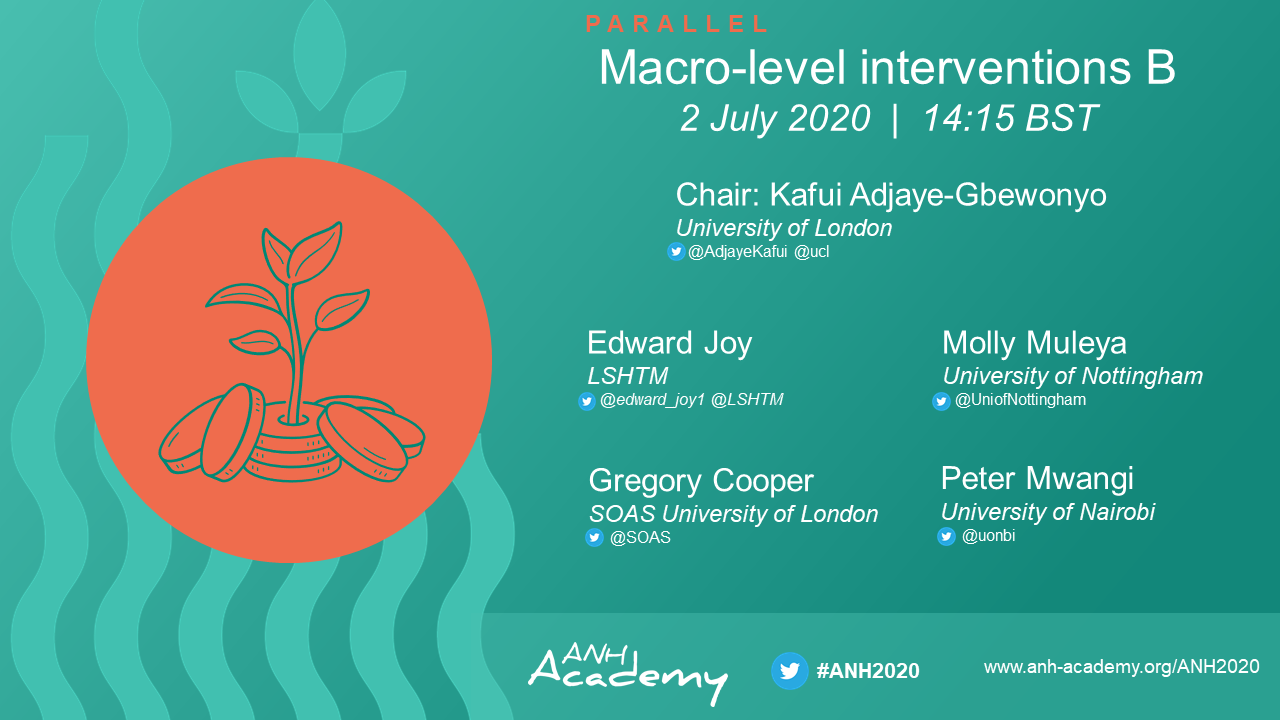
Intro animation:
Session recording:
Speakers and presentations:
-
Session chair: Kafui Adjaye-Gbewonyo, University College London
@AdjayeKafui @ucl -
Edward Joy, London School of Hygiene & Tropical Medicine
@edward_joy1 @LSHTM
First report of primary findings from the AHHA trial: can selenium deficiency in rural Malawi be addressed through consumption of maize flour biofortified with fertilizers?
Presentation | Slides -
Gregory Cooper, SOAS University of London
@SOAS
Navigating the nutrition-based trade-offs arising from horticultural aggregation schemes: a system dynamics approach
Presentation | Slides -
Molly Muleya, University of Nottingham
@UniofNottingham
Biofortification of staple crops with selenium fertilizers: speciation and bioaccessibility
Presentation | Slides -
Peter Mwangi, University of Nairobi
@uonbi
Effects of area yield index insurance on food security: Case study of Njoro sub-county, Kenya
Presentation | Slides
Abstracts:
First report of primary findings from the AHHA trial: can selenium deficiency in rural Malawi be addressed through consumption of maize flour biofortified with fertilizers?
Edward J. M. Joy1
Alexander A. Kalimbira2
Dawd Gashu3
Elaine L. Ferguson1
Joanna Sturgess1
Alan D. Dangour1
Leonard Banda2
Gabriella Chiutsi-Phiri4
Zione Kalumikiza2
Elizabeth H. Bailey5
Simon C. Langley-Evans5
R. Murray Lark5
Kate Millar5
Scott D. Young5
Limbanazo Matandika6
Joseph Mfutso-Bengo6
John C. Phuka6
Blessings H. Likoswe6
Felix P. Phiri5,7
Jellita Gondwe8
E. Louise Ander9
Nicola M. Lowe10
Patson C. Nalivata2
Martin R. Broadley5
Elizabeth Allen1
1Faculty of Epidemiology and Population Health, London School of Hygiene & Tropical Medicine
2Lilongwe University of Agriculture and Natural Resources, Malawi
3Center for Food Science and Nutrition, Addis Ababa University, Addis Ababa, Ethiopia
4Lilongwe University of Agriculture and Natural Resources, Malawi
5School of Biosciences, University of Nottingham, UK
6School of Public Health and Family Medicine, College of Medicine, University of Malawi, Blantyre, Malawi
7Department of Nutrition, HIV and AIDS, Ministry of Health, Lilongwe, Malawi
8Public Health Institute of Malawi, Community Health Sciences Unit, National Nutrition Reference Lab, Lilongwe, Malawi
9Inorganic Geochemistry, Centre for Environmental Geochemistry, British Geological Survey, Nottingham, UK
10UCLan Research Centre for Global Development, University of Central Lancashire, UK
Introduction
Selenium (Se) deficiency is widespread in Malawi1 where most crops are grown on highly-weathered, tropical soils with low concentrations of plant-available Se. Concentrations of Se in maize, the staple cereal of Malawi, can be increased through application of Se fertilisers2 – a process known as agronomic biofortification – and this may contribute to alleviating deficiencies3. The Addressing Hidden Hunger with Agronomy (AHHA) trial was recently completed with the aim of establishing the efficacy of agronomic biofortification for improving Se status in rural Malawi4. The primary results of the AHHA trial will be presented here for the first time.
Methods
A double-blind, randomised, controlled trial was conducted in rural Kasungu District, Malawi. We hypothesised that consumption of maize flour agronomically-biofortified with Se would increase serum Se concentration. A study area of ~1200 households was defined in Wimbe Traditional Authority, where Se deficiency is widespread1. 180 women of reproductive age (20–45 years) and 180 school-age children (5–10 years) were recruited and randomly assigned in a 1:1 ratio to receive either maize flour enriched through agro-biofortification with Se or control flour not enriched with Se. Households received adequate flour to meet household requirements (330 g/capita/day) for 12 weeks, with distributions every 2 weeks. Non-participant households received control-equivalent flour to reduce chances of inter-household sharing. Blood samples were drawn from participants at baseline (prior to flour distribution) and end-line (after 8-9 weeks of flour distribution). Samples were centrifuged in the field to extract serum which was aliquoted and frozen. Dietary data for adult women was collected by interactive 24-hour recall. Serum Se concentrations will be measured by inductively coupled plasma mass spectrometry in February 2020. Data will be analysed on an ‘intention-to-treat’ basis, with analysis of covariance used to estimate a mean difference in Se status between the control and agronomically-biofortified trial arms.
Findings
The trial was successfully completed in September 2019 and the results will be known in March 2020 when the trial is unblinded. Primary findings will be presented here for the first time. A total of 360 participants were recruited and 345 (96%) completed the trial, defined as providing blood samples at baseline and endline. The low drop-out rate was largely thanks to intensive community sensitisation efforts led by the research team together with local government and community partners. Community fears and rumours arose, e.g. fears that blood sampling was linked to witchcraft, or that consumption of the maize flour would cause infertility. However, these were successfully addressed through community events such as visits to the maize production site and dish sharing, and managed communication strategies including regular meetings arranged by the Trial Manager and community representatives, and the development of a Frequently Asked Questions document which all Research Assistants were familiarised with before going to the field. In total, >200 tonnes of maize flour were distributed during the trial, with >99.5% accuracy in terms of correctly allocated flour. A total of 695 monitoring visits were conducted when adherence to treatment and adverse events such as diarrhoea were captured.
Conclusion
The AHHA trial will determine whether agronomic biofortification may be an effective approach to address Se deficiency in rural Malawi. Previous studies have suggested it may be a cost-effective strategy with the potential to reach poorer and marginalised populations who lack access to diverse diets or foods fortified at processing stage5. A national policy of agronomic biofortification with Se has been implemented in Finland since 1984, successfully addressing Se deficiency in the population. The AHHA trial will provide important evidence on the potential to alleviate Se deficiency through agronomic biofortification in the context of rural Malawi.
References
Phiri FP, Ander EL, Bailey EH, Chilima B, Chilimba AD, Gondwe J, Joy EJ, Kalimbira AA, Kumssa DB, Lark RM, Phuka JC. The risk of selenium deficiency in Malawi is large and varies over multiple spatial scales. Scientific reports. 2019 Apr 25;9(1):6566.
Chilimba AD, Young SD, Black CR, Meacham MC, Lammel J, Broadley MR. Agronomic biofortification of maize with selenium (Se) in Malawi. Field Crops Research. 2012 Jan 18;125:118-28.
Alfthan G, Eurola M, Ekholm P, Venäläinen ER, Root T, Korkalainen K, Hartikainen H, Salminen P, Hietaniemi V, Aspila P, Aro A. Effects of nationwide addition of selenium to fertilizers on foods, and animal and human health in Finland: From deficiency to optimal selenium status of the population. Journal of Trace Elements in Medicine and Biology. 2015 Jul 1;31:142-7.
Joy EJM, Kalimbira AA, Gashu D, Ferguson EL, Sturgess J, Dangour AD, Banda L, Chiutsi-Phiri G, Bailey EH, Langley-Evans SC, Lark RM. Can selenium deficiency in Malawi be alleviated through consumption of agro-biofortified maize flour? Study protocol for a randomised, double-blind, controlled trial. Trials. 2019 Dec;20(1):1-9.
Joy EJM, Kumssa DB, Broadley MR, Watts MJ, Young SD, Chilimba ADC, Ander EL. Dietary mineral supplies in Malawi: spatial and socioeconomic assessment. BMC nutrition. 2015 Dec;1(1):42.





